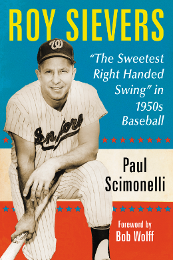The Senators rode the momentum of Walter Johnson’s amazing opening day performance to win two of the next three from the Athletics. Washington won the second game of the season, 3-1, behind another well-pitched game, this one by Stan Coveleski, Washington’s other twenty-game winner in 1925. In fact, the only run allowed by Coveleski was due to Myer’s second error of the season. However, the rookie shortstop was able to redeem himself by knocking in his first career RBI.
The Athletics bats finally came to life in the third game for nine runs against Bullet Joe Bush in a 9-3 win. Washington won the final game of the series, 4-3, thanks to a good pitching effort by Dutch Ruether.
Babe Ruth and the improved New York Yankees came to town for the next series. In 1925 the New Yorkers were expected to win the pennant, but finished a disappointing seventh. Babe Ruth’s illness and his late season suspension by his manager, a poor defensive infield, and an off-season by the pitching staff, contributed to the Yankees downfall. But now Ruth was said to be in great shape and was displaying a better attitude, but most believed his best days were behind him. The Yanks believed they had solved infield problem with two rookies in second baseman Tony Lazzeri and shortstop Mark Koenig. Joe Dugan was back after a season-ending knee injury in 1925 and first baseman Lou Gehrig showed amazing progress after taking the starting first baseman’s job away from Wally Pipp in June of 1925.
With a belief that Ruth’s best days were behind him, the liability of having two rookies in the middle infield, and the pitching staff said to be old, the prediction by most for the 1926 Yankees to repeat their seventh place finish.
After the two teams splitting two games and a rainout, Walter Johnson took the mound following seven consecutive days of rest. Harris believed it was best to rest him after throwing 15 innings in his opening day master piece. But there would be no masterpiece game today for the Big Train on this day. He would be gone after three innings.
In the first inning, Babe Ruth greeted Johnson with a mammoth home run into the far distances beyond the confines of Griffith Stadium. “The ball was hit halfway across the District of Columbia,” wrote James Harrison of the New York Times. “Those who saw it thought it was an Army dirigible that went by.”
confines of Griffith Stadium. “The ball was hit halfway across the District of Columbia,” wrote James Harrison of the New York Times. “Those who saw it thought it was an Army dirigible that went by.”
Ruth and the Yankees were just warming up. When the game had ended, New York had won, 18-5. Ruth finished the day with 5 hits in 6 trips to the plate, including two hits through the infield “that were hit so hard the infielders never saw the ball.”
As the Yankees rolled up the score, the hometown crowd grew increasingly angry. They booed and booed the Nats throughout the game and sang them the raspberries, with one line calling the team a bunch of hams.
After the embarrassing 13-run loss, Harris admitted he made a mistake by over-resting his ace hurler. Three days later, the youthful Washington manager sent Johnson to the hill at Philadelphia where he was hit hard but was able to pitch out of most of the jams in a 9-5 Washington win. In his fourth start, at Boston, Johnson appeared to be back in form. He scattered just four hits and allowed only one run for his third win of the season. The Nats gave the Big Train plenty of support. Bluege hit a 3-run home run and Goslin whacked three hits to boost his average to .429.
How soon until Peckinpaugh would return? Like at Tampa during spring training, the weather along the east coast was unseasonably cold. Not wanting to risk a long-term injury to the 1925 MVP’s lame legs, Harris insisted on keeping him out of action until the weather got warmer. But his players, the sportswriters and fans were becoming restless. Like the Nats, Myer was off to a slow start, causing several players to grumble over Peckinpaugh not being in the lineup. The Washington players were divided on Myer. Some thought he was no major league player; others felt he would be good, but needed time. But he was hitting just .189 and already had made four errors. “Myer is proving to be a wink link,” wrote James Harrison. The numbers backed that up. The Nats had turned just seven double plays.
Washington closed out April at New York to take on the red-hot Yankees, who had won 10 of their first 13 games and were averaging seven runs per game. The Nats lost the first two games of the series, and hardly looked like a championship team. Following the second game, Harris announced that the time was right to put Peckinpaugh into the lineup. “We simply have got to strengthen our defense until we start hitting,” Harris told the press. He also said he still believed in his rookie shortstop. “He (Myer) has shown me enough to convince me he is a Diamond in the rough.”
The players let out a sigh of relief, until Harris had a change of heart at game time. He elected to give Myer one more start. His decision would prove to be costly.
In the bottom of the first Myer booted one which led to a four run inning and a 4-1 New York win. Later in the game Myer committed another error.
The next morning the Washington Star placed the blame of the loss on the shoulders of Myer. In addition to his defensive woos, he was not hitting just .170. Also mentioned was that the Senators were looking at a colligate shortstop due to Myer’s disappointing start. The Senators angrily denied the story.
The Nationals were now 9-9 and already six behind the Yankees. Nonetheless, their manager was not giving up. “I don’t consider these Nationals out of the race this year,” he said. “We will regain our poise; we will start a winning streak that will carry us to the top.”
The Washington starting shortstop job once again belonged to Roger Peckinpaugh. He was in the starting lineup when the Senators returned home from New York to take on the Athletics. And with the presence of their leader, the Nats looked like a championship team for the first time during the season in a 4-3 win. Walter Johnson pitched the win to up his record to 4-1, and the Nats did not make a single error. From there the Nats went to Boston and swept the three game series. Suddenly, the Nats were on a four-game winning-streak. They extended the streak with a 5-3 win at New York, with Peckingpaugh socking his first home run of the season. A win against Chicago, as Johnson won again, made it six straight. Finally, the streak ended with an 11-5 loss to the next day.
Buddy Myer was a good sport about his demotion and his new role as late inning substitution. With Peckinpaugh’s legs still not at one-hundred percent, Harris would sub Myer for his star fielding shortstop in the late innings. Against Chicago, with the Nats clinging to a one-run lead, Myer, who had replaced Peckinapugh late in the game, made a fielding gem to save the day.
There were two outs, a runner on second, and the score was 6-5 in favor of Washington. White Sox fast second baseman Eddie Collins grounded one through the middle for what looked to be a sure hit. Myer reacted by scooting to his left, and he managed to glove the ball behind the second base bag. Knowing he had a fast man running down the first base line, the rookie knew there was no time to straighten up to make the throw. He quickly threw the ball to first baseman Joe Judge, and in time to get the speedy Collins to end the game.
After loss the following day, Washington took three in a row from the Browns, with Johnson pitching a win to up his 1926 record 6-1. Washington had now won 10 wins of their last 12 games and moved ahead of New York into first place. The Senators were finally where they believed they ought to be.
1926 Washington Senators – Part One
1926 Washington Senators – Part Two
1926 Washington Senators – Part Three
Gary is the author of The Wrecking Crew of ’33; The Washington Senators’ Last Pennant. Gary has written for Nats News, Minor League News, and for the Biography Project of the Society for American Baseball Research. He lives in Arlington, Virginia.






